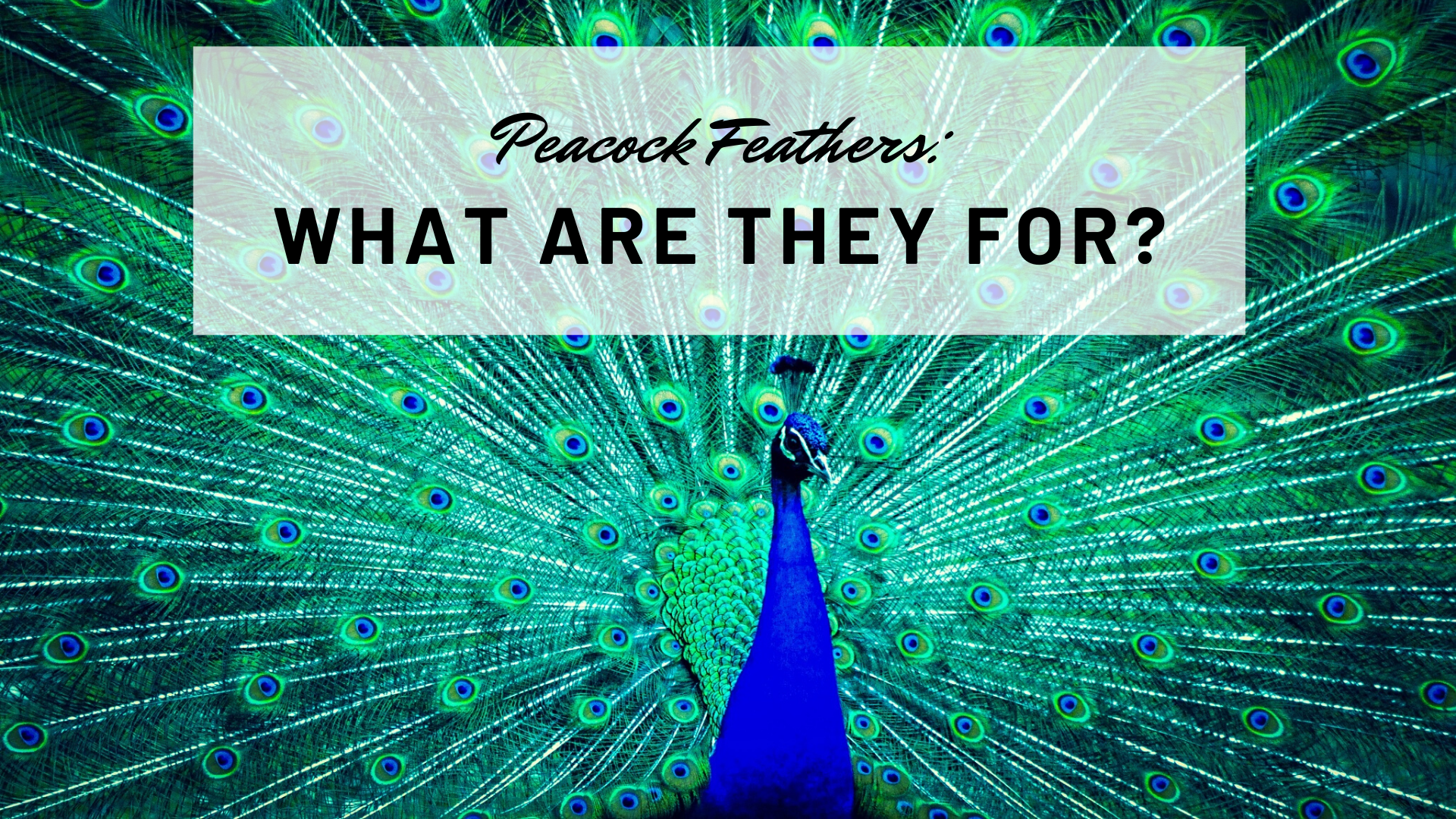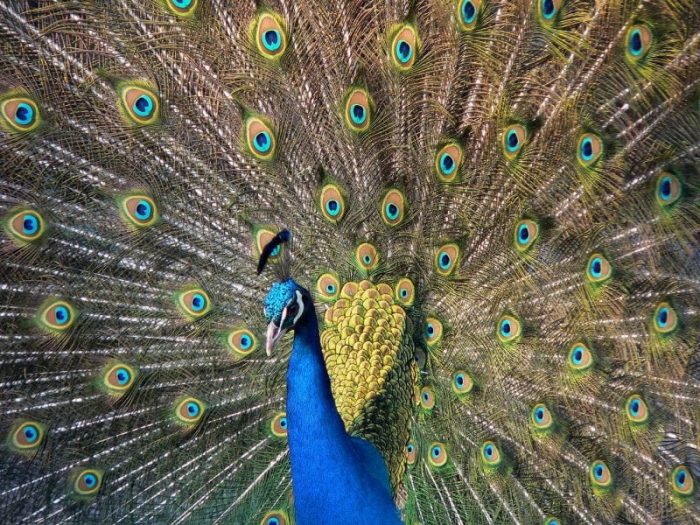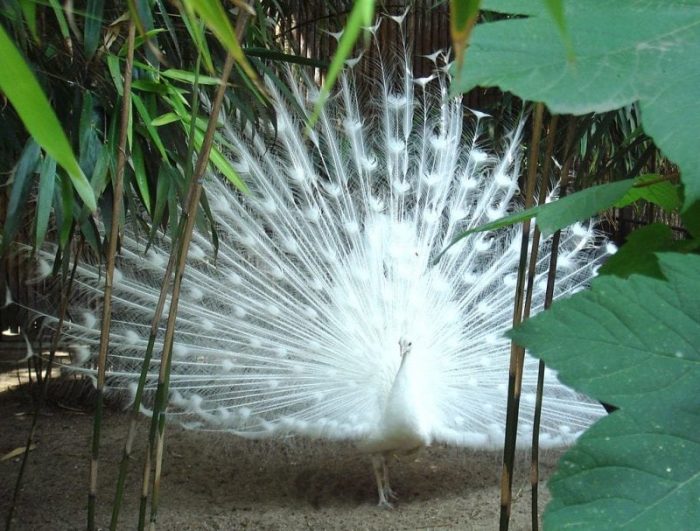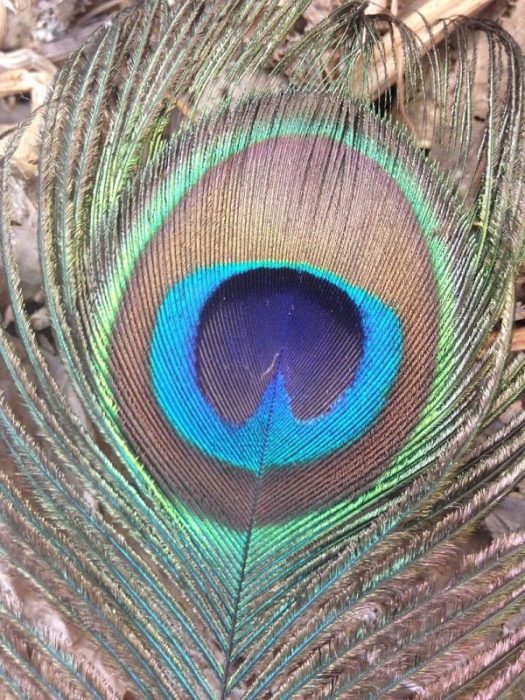
Peacock colors, mimicking the vibrant colors of a Peacock feather, are a great theme for any celebration. They include the colors turquoise, green, purple, and a deep royal blue.
Peacocks are known for their iridescent and extravagant tail feathers. What is the function of these tail feathers? Do different kinds of peacocks have different colors of tail feathers? The short answer to these questions is: to attract mates, and yes.
Yet to adequately answer these questions, it would be helpful to know a little more about peacocks themselves.
“The pride of the peacock is the glory of God.” — William Blake
Facts About Peacocks (Peafowls)

Photo: By BS Thurner Hof – Photo taken by user BS Thurner Hof, CC BY-SA 3.0, https://commons.wikimedia.org/w/index.php?curid=63857
Kinds of Peafowls:
- Indian Peafowl
- Green Peafowl
- Congo Peafowl
Peacocks are the males of the species of birds called peafowl, though sometimes the term peacock is used to refer to both sexes of peafowls. There are three different species of peafowl: the Indian peafowl the green peafowl and the Congo peafowl. The Indian peafowl and the green peafowl are known for the iridescent colors of their tail feathers, while the Congo peafowl tends to have more drab tailfeathers. The Indian peacock is also called the blue peacock and it is found throughout India and Sri Lanka. The green peacock is typically found in areas like Myanmar and Java. The Congo peacock is only found throughout the rainforests that make up the Congo.
“Many a peacock hides his peacock tail from all eyes and calls it his pride.” — Friedrich Nietzsche
Peafowl, in general, are one of the biggest birds capable of flight. The length of their tails can be as long as 5 feet in length, and the birds can weigh somewhere between 8 to 13 pounds. The tail of a peafowl can form almost 3/5ths of a peafowl’s length. Peafowls subsist on a variety of different meals. Peafowl eat things like flowers and seeds, but they also eat small amphibians and insects. Peafowl typically hunt for their food at dusk or in the early morning, and they spend the middle portion of the day sheltering themselves under the shade of trees. Peafowls typically live around 20 years in the wild.
When it comes to mating, peacocks will frequently try to gather a harem of peahens around them. These peahens typically lay around 4 to 6 eggs in a clutch. To attract mates, peacocks will spread their tail feathers wide into fans. They then walk around shaking their tail feathers to catch the attention of females in the group.
Peafowl are quite intelligent, capable of deception. A recent study suggests that peacocks are capable of faking sexual success to make themselves more attractive to mates. The birds apparently emit a “copulatory call” when they mate with peahens, and the birds can give this call even when they aren’t actually mating. This may have the effect of making themselves appear more sexually fit and active than their rivals. The authors of the study say that up to one-third of the copulatory calls given off by the birds were fake.
The Color of Peafowls
The blue peafowl, or Indian peafowl, is the peafowl that is arguably the most famous out of all the peafowl. It is found in a much larger habitat range than the other types of peafowl. The blue peacock doesn’t just have impressive tail feathers, the feathers of the bird’s neck and the rest of its body are a bright blue color and they shimmer in the light, turning blue-green.
The green peafowl, as its name implies, has green feathers across its face, neck, and body. It looks fairly similar to the blue peafowl, aside from the color of its feathers. There are even white peafowls, the result of a mutation in the peafowl’s DNA. This mutation is called leucism, and it is distinct from albinism. In the case of being an albino, the animal usually develops red eyes, but in the case of leucism, the peafowl keeps its normal eye color.

Photo: By BS Thurner Hof – Photo taken by user BS Thurner Hof, CC BY-SA 3.0, https://commons.wikimedia.org/w/index.php?curid=63857
So why do the tail feathers of peacocks have their characteristic shimmering iridescence? There are basically two different ways that the feathers of birds can get their color. The color of a feather can be influenced by both its pigments and the structure of the feather itself.
Interference Coloration
Pigments are particles that are capable of absorbing a certain wavelength of light. A red shirt gets its color from absorbing all of the light in the visible spectrum except for the color red, which is reflected back and into our eyes. The other way that feathers can get color is due to their structure, which can absorb or reflect certain wavelengths of light. Think of how sunlight can bend off of certain surfaces to create colors, like the colors seen in a soap bubble. This process is sometimes referred to as interference.
In the case of peacock feathers, it’s the structure of the feathers that are responsible for their striking colors. The feather of a peacock is built like a palm-frond. There’s a rigid stem in the center of the feather, with rows of tiny barbs branching off of it. Each of the barbs is sub-divided into rows of barbules, which are even smaller. These barbules are built out of two different substances, keratin, and melanin. Keratin is a material that the human body uses to create fingernails and toenails, while melanin is a pigment found in human skin.

Photo: By Satdeep gill – Own work, CC BY-SA 3.0, https://commons.wikimedia.org/w/index.php?curid=31034818
The barbules have a complex outer covering made up of interconnected melanin rods linked together by sections of keratin. Analysis of the barbules with an electron microscope showed that the keratin and melanin form matrices that vary in how close they are to one another. Rods can be packed closely together, or far apart from one another. Depending on how many rods were packed into space together, the color of the barbule can change from green to blue or from brown to yellow.
“The peacock that rests on his feathers is just another turkey.” — Dolly Parton
When the barbules were dipped in glycerin by researchers, the tiny air holes in-between the sections of rods and keratin were filled with liquid. The glycerin actually changed the colors of the feathers, suggesting it isn’t a pigment that influences the color of the feathers, but how close the rods are to one another. The color of the feather is actually changed by changes in the structure of the melanin/keratin matrix. One particular matrix layout could reflect back the blue parts of the visible spectrum, while a different arrangement would reflect back red. This is similar to how water droplets, which are colorless, reflect light and produce all the different colors of the rainbow in the air.
The mechanism of interference that gives peacocks their iridescence is also seen in other animals. Animals like catfish, butterflies, cephalopods, and other birds like the Nicobar pigeon also have iridescent color schemes. Iridescence is rare in mammals, and the golden mole may be the only known example of a mammal with interference coloration. It’s thought that while the peacock may use its iridescence to signal to mates, other animals may use it as a defensive mechanism. The shimmering colors that occur when an iridescent animal moves may make it harder for predators to track it, confusing its prey about its exact location.









